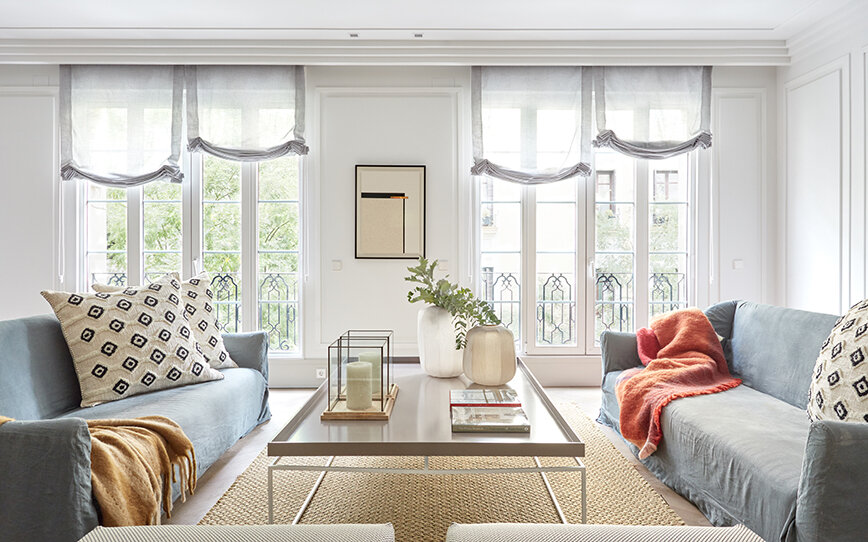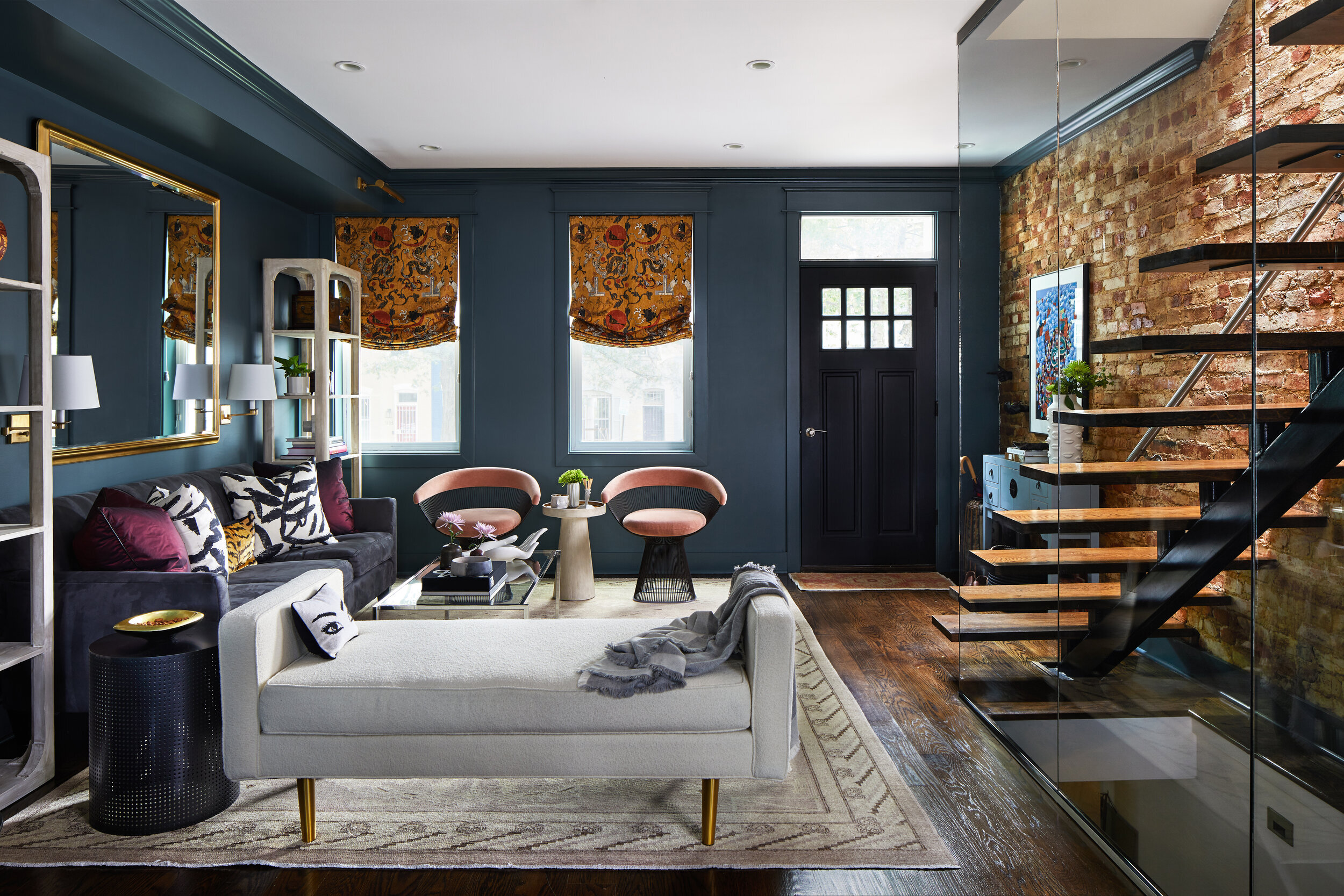And the winner of the window treatments contest is … Roman Shades!
Let’s talk about the interior elevations in a space. I’m referring to the planes of your rooms that your eyes are most in contact with as you move through your home - your walls! There are only so many ways to dress up your walls - paint, wallpaper, art & window treatments! Of these, window treatments not only offer functional value in terms of privacy and light control, but they are the simplest way to aesthetically transform and personalize a space. Window treatments are crucial in creating a ‘finished’ space.
Roman Shades are hands down my favorite type of window treatment! They are the most modern of the soft window treatments category and so can bring current any style of home. The are sophisticated without being too formal. Because they primarily cover only the windows, they keep the room feeling light. The soft folds of fabric lends an airiness to the space. They are functional, as you can choose to keep the window partly or entirely covered, depending on your needs. They are a good solution for when you don’t have the wall space to stack draperies or your window is in between built-ins or over a banquette. They’re just an all round versatile solution.
Fabric, Lining & Trim
You want a fabric that will easily fold - so avoid stiff, heavy, embellished fabrics, and fabrics that crease easily. Lining in Roman Shades does have a function other than to add weight to the fabric. It hides the strings at the back of the shade that lift the shade. Not all fabrics need to be lined, sheers are a good example of this where you want to highlight the lightness of the fabric itself. For a more luxurious look, you might self line the shade with the face fabric and this will help obscure the lift strings. The lining is also how you decide how much light filtering you need whether sheer, blackout, or somewhere in between.
Unlined, sheer relaxed shades add a soft and easy vibe to this living room.
Designer: Tristan Domecq | Interiorismo
Relaxed shades in a printed fabric are used to add a bold and fun vibe to this living room.
Designer: Zoë Feldman Design
Inside mount vs. outside mount
My preference is to inside mount whenever possible. The reason being that window casing (also referred to as molding or trim), whether plain or decorative, is a great architectural feature to highlight. Even in the case of a modern window with no casing, inside mounting is still a great idea as it highlights the clean lines of the wall opening.
There are times when inside mounting does not makes sense. Firstly, you might have shallow window depth which restricts the ability to cleanly inset the headrail of the shade. If your goal is to block light, I would avoid inside mounted shades, as there is generally a gap between the window treatment and the frame. If you have tiny or awkwardly shaped windows, inside mounted shades would only bring more attention to them.
Controls
There are three basic controls for Roman Shades - cord and cleat, continuous loop and motorized.
I prefer the cord and cleat system to the continuous loop system simply because I think a cord is more aesthetically pleasing than a beaded chain. It is also not as noisy as a beaded chain. However, cords can be finicky and you have to operate your shades with some grace if you want to avoid tangles and snags. With cords, the shade might lift lopsided (especially if it is a top down bottom up style) and you will have to play with the cords to set it straight. So either system is not ideal and selecting one really is a matter of eliminating which downside bothers you more!
Motorized shades obviously offer the most convenience, but they come at a price and require electrical wiring.
Styles
While there are plenty of styles to choose from in this category, I will stick to the few that I recommend.
FLAT
RELAXED
PLEATED
Flat
My go-to style; clean, versatile, no drama, works with any style of space. The flat appearance gives a modern edge to this soft shade. It is particularly great in accentuating the color or pattern in the fabric, although it is great in bringing out the texture in a plain linen shade as well.
Relaxed Roman Shades
These are great if your style is a little more traditional or if you prefer a softer, cozier feel. They don’t have rigid supports on the inside, which allows the fabric to gently sag with its own weight, creating a curve at the bottom. There is a relaxed charm to this style. I think these are perfect in a bedroom. They’re also great when used with a sheer fabric; in applications where you don’t need window coverings for privacy but just need to soften up the windows.
Pleated, Hobbled, Slatted, Cascade
These Romans have a structured appearance due to the way they are constructed with sewn in rods. These offer a more tailored, traditional look than the relaxed style. The supports also make these type of shades more suitable to wider windows. For a contemporary feel, I would keep the fabric plain (not patterned).
Designer tips for detailing Roman Shades
Details: Whenever you can, try to match the color of the cord & fabric lining to the fabric itself so as to not call attention to the cord and lining. Decorative trim (not for the minimalist), adds a unique personalized touch to your window treatments.
Top down bottom up: This feature offers the perfect balance between light control and privacy. It allows you to lower shades from the top and/or raise from the bottom to fully control light and privacy. The downsides are that this feature does cost more, and you will have 2 sets of cord controls - one on either side.
Valance returns: A valance is a must have to create a custom, finished look. I prefer the valance to be wrapped in the same fabric that is being used for the shade. Valance returns are side pieces added to a standard valance from the face of the valance to the mounting plane. Their purpose is to cover the exposed hardware and create a finished look.
Add decorative trim to roman shades to create window treatments that are unique to your home!
Designer: Leonora Birts Interior Design
Top down bottom roman shades help you maintain privacy while letting you enjoy the light and views.
Designer: Via D’sa Interior Design
A slatted style lends formality to the space because of the ribbed structure. These shades are outside mounted so as to form a continuous band of color that distracts from the window casing. This is also a great example of how valance returns (the sides of the valance) create a finished look by hiding the hardware behind the valance.
Designer: Kristin Riccio Interior Design
As you can see my love for Roman Shades runs deep!
However, the entire category of custom window treatments is one of the favorite aspects of my job. They are a great investment for any home as they add function + aesthetic impact! Just imagine the space in the image above without any window coverings?!
If you are overwhelmed by the options out there or need help pinning down the fabric or style, schedule a call today to see how I can help!








